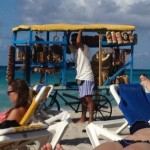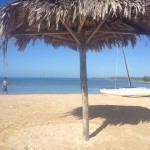All-Inclusive Hotels
May 4, 2012 by admin
During our trip to Cuba, we had the opportunity to stay at many different types of hotels. Our hotel in Havana, Hotel Plaza, offered a beautiful roof-top view of the city and is close to Calle Obispo and Havana vieja. Hotel Plaza was a multi-level hotel that had an indoor restaurant, gift shop, and money exchange counter. As we traveled around Cuba, we stayed at different hotels. Our next hotel was Hotel Playa Girón, in Cinega de Zapata. The hotel was outdoors, with houses spaced out throughout the area, all within walking distance to the beach. It contained two bars and multiple restaurants. Hotel Rancho Luna, once again located on the beach, had multiple bars and restaurants and a large swimming pool. What can only be described as a luxurious campsite hotel, Hotel Villa Guajimico has houses spread out on a mountain slope, with a beautiful lake at the bottom. Our next two hotels, Hotel Ancón in Trinidad, and Hotel Barlovento in Varadero, were extravagant tourist hotels, with both the beach and swimming pools, free flowing alcohol and extra amenities (like sailing).
- Hotel Barlovento
- Hotel Playa Girón
- Hotel Plaza
- Hotel Rancho Luna
While all of these hotels were in different places and offered different comforts, one thing was true for our group-whenever we knew we were heading to an all-inclusive hotel, we were excited! Personally, I imaged all-inclusive hotels as lavish establishments that allowed guests to do whatever they want, and drink and eat whatever they want. The concept of all-inclusive hotels was first introduced in “holiday camps in Britain during the 1930s” (Issa and Jayawardena 2003). The main purpose behind the all-inclusive hotels was to eliminate the extra charges that can be racked up during a vacation visit. The all-inclusive hotels in Cuba, such as Hotel Ancón and Hotel Barlovento, had each guest wear a wrist-band that defined them as all-inclusive guest allowing them to receive and participate in most activities. By having guest wear wrist-bands, they are creating a tourist visit that does not require guest to carry around money (Issa and Jayawardena 2003). All-inclusive hotels allow guest to be protected from the outside “foreign” environment (Issa and Jayawardena 2003). For Hotel Ancón, the location of the hotel itself isolated tourist, since it was around a ten minute drive to the town of Trinidad. While I was originally charmed by the idea of staying in all-inclusive Cuban hotels, I soon came to dislike their secluded location. Only our hotel in Havana allowed us to go explore the city at night.
Fun Facts
- “Cuba has become the third most popular tourism destination in the Caribbean region and the second destination in the region for Europeans” (Cerviño and Bonache 2005).
- “48 of the best 100 all-inclusive resorts are in the Caribbean” (Issa and Jayawardena 2003)
- “The total number of hotels at the end of 2003 amounts to 263 with around 47,500 rooms, giving Cuba the second largest hotel capacity in the Caribbean” (Cerviño and Bonache 2005).
Sources
1. Cerviño, Julio, and Jaime Bonache. “Hotel Management in Cuba and the Transfer of Best Practices.” International Journal of Contemporary Hospitality Management 17.6 (2005): 455-68.
http://www.emeraldinsight.com/journals.htm?articleid=1515228&show=abstract
2. Issa, John J., and Chandana Jayawardena. “The “all-inclusive” Concept in the Caribbean.” International Journal of Contemporary Hospitality Management 15.3 (2003): 167-71.
http://www.emeraldinsight.com/journals.htm?articleid=867473&show=html
Leave a Reply
You must be logged in to post a comment.



